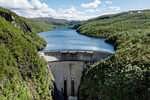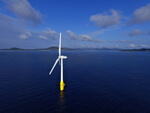08/05/2012
This week: Newest Research - Innovative insights into the size of wind turbines and the impact on the environment
The study, published in the American Chemical Society’s Environmental Science & Technology journal, is the result of research by Swiss and Dutch Scientists, led by Marloes Caduff from ETH Zurich’s Institute of Environmental Engineering.
The results of their research showed that the larger the turbine is, the greener the electricity. This effect was due both to size of the turbine as well as the learning and experience gained with the technology over time.
"The environmental progress rate was 86%, indicating that for every cumulative production doubling, the global warming potential per kWh was reduced by 14%," says the report.
"The parameters, hub height and rotor diameter were identified as Environmental Key Performance Indicators that can be used to estimate the environmental impacts for a generic turbine."
The entire report can be found at http://pubs.acs.org/doi/pdf/10.1021/es204108n
ABSTRACT:
Wind energy is a fast-growing and promising renewable energy source. The investment costs of wind turbines have decreased over the years, making wind energy economically competitive to conventionally produced electricity.
Size scaling in the form of a power law, experience curves and progress rates are used to estimate the cost development of ever-larger turbines. In life cycle assessment, scaling and progress rates are seldom applied to estimate the environmental impacts of wind energy. This study quantifies whether the trend toward larger turbines affects the environmental profile of the generated electricity. Previously published life cycle inventories were combined with an engineering-based scaling approach as well as European wind power statistics.
The results showed that the larger the turbine is, the greener the electricity becomes. This effect was caused by pure size effects of the turbine (micro level) as well as learning and experience with the technology over time (macro level). The environmental progress rate was 86%, indicating that for every cumulative production doubling, the global warming potential per kWh was reduced by 14%. The parameters, hub height and rotor diameter were identified as Environmental Key Performance Indicators that can be used to estimate the environmental impacts for a generic turbine.
The results of their research showed that the larger the turbine is, the greener the electricity. This effect was due both to size of the turbine as well as the learning and experience gained with the technology over time.
"The environmental progress rate was 86%, indicating that for every cumulative production doubling, the global warming potential per kWh was reduced by 14%," says the report.
"The parameters, hub height and rotor diameter were identified as Environmental Key Performance Indicators that can be used to estimate the environmental impacts for a generic turbine."
The entire report can be found at http://pubs.acs.org/doi/pdf/10.1021/es204108n
ABSTRACT:
Wind energy is a fast-growing and promising renewable energy source. The investment costs of wind turbines have decreased over the years, making wind energy economically competitive to conventionally produced electricity.
Size scaling in the form of a power law, experience curves and progress rates are used to estimate the cost development of ever-larger turbines. In life cycle assessment, scaling and progress rates are seldom applied to estimate the environmental impacts of wind energy. This study quantifies whether the trend toward larger turbines affects the environmental profile of the generated electricity. Previously published life cycle inventories were combined with an engineering-based scaling approach as well as European wind power statistics.
The results showed that the larger the turbine is, the greener the electricity becomes. This effect was caused by pure size effects of the turbine (micro level) as well as learning and experience with the technology over time (macro level). The environmental progress rate was 86%, indicating that for every cumulative production doubling, the global warming potential per kWh was reduced by 14%. The parameters, hub height and rotor diameter were identified as Environmental Key Performance Indicators that can be used to estimate the environmental impacts for a generic turbine.
- Source:
- American Chemical Society’s Environmental Science & Technology journal
- Author:
- Posted by Trevor Sievert, Online Editorial Journalist
- Email:
- ts@windfair.net
- Link:
- www.windfair.net/...
- Keywords:
- wind, wind energy, wind turbine, rotorblade, awea, ewea, wind power, suppliers, manufacturerstrevor sievert
























